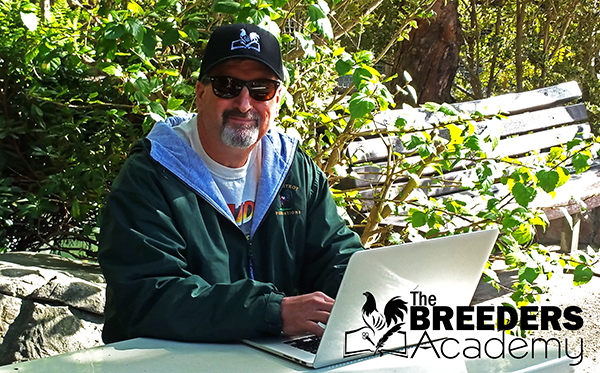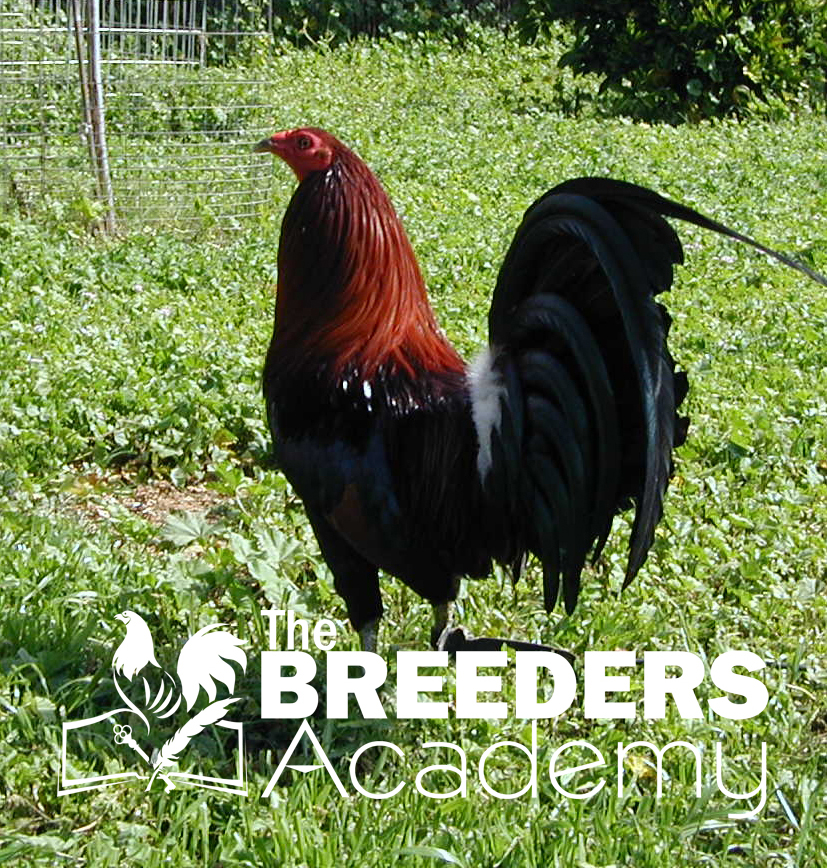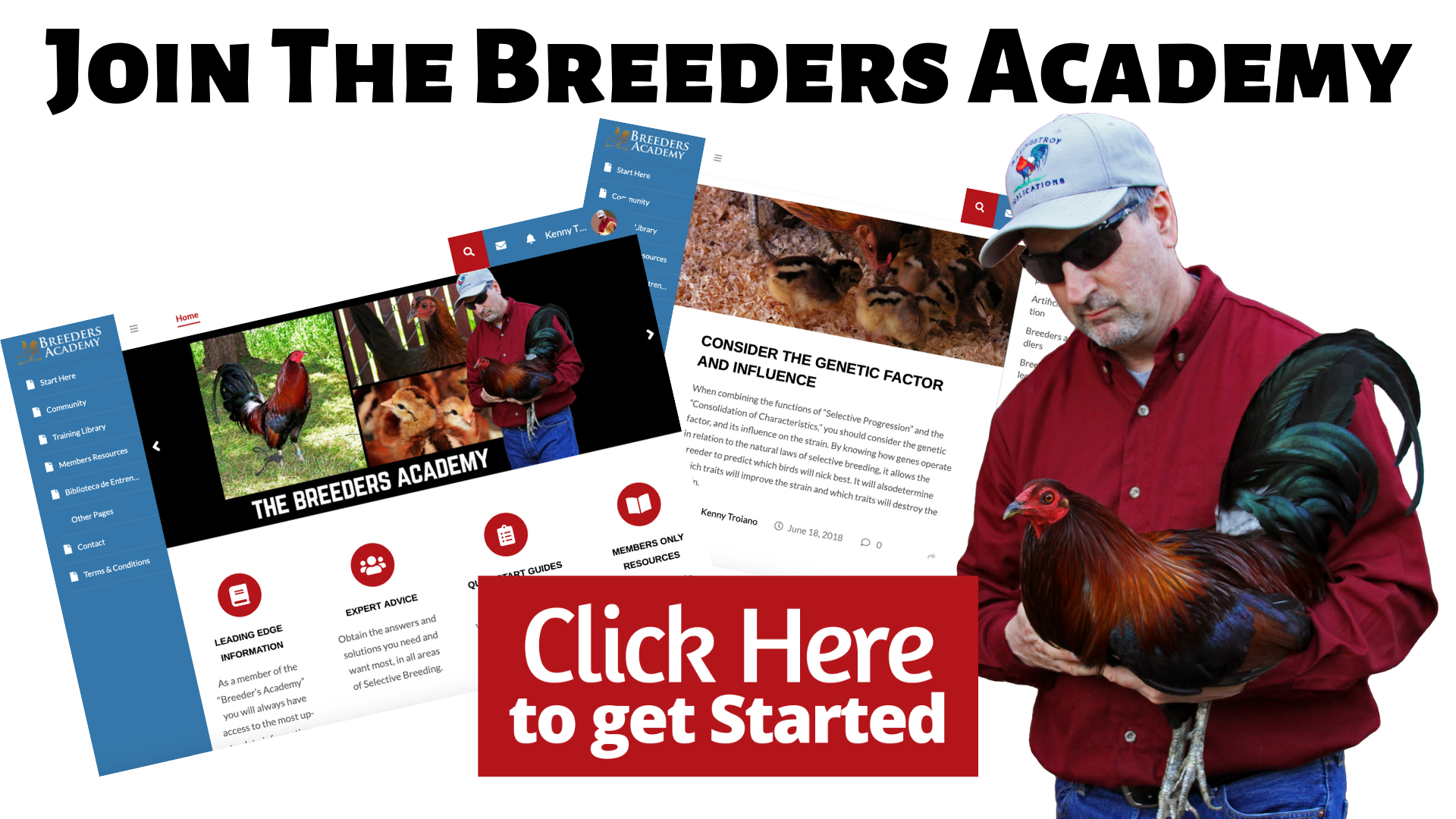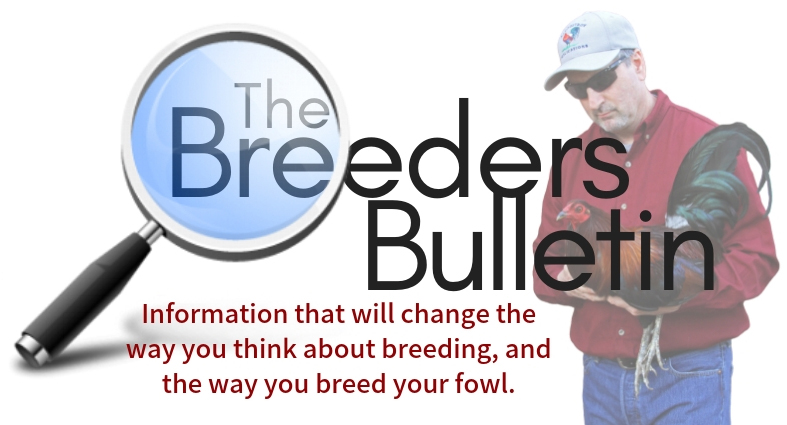Genetic Purity and the Importance of a Good Foundation Bloodline
By Kenny Troiano
 For many years, American Gamefowl Breeders thoughts, regarding “gamefowl breeding” have been largely dominated by the pit game philosophy. The general substance of the theory is that although there are obvious differences between purebreds and crossbreds, the purebred, by virtue of being a purebred, are overall weaker than crossbreds.
For many years, American Gamefowl Breeders thoughts, regarding “gamefowl breeding” have been largely dominated by the pit game philosophy. The general substance of the theory is that although there are obvious differences between purebreds and crossbreds, the purebred, by virtue of being a purebred, are overall weaker than crossbreds.
The theory goes even further by stating that gamefowl cannot be bred pure at all, and be successful in today’s tough competition.
The truth is, purebreds are much more superior to crossbreds. In fact, it is better to replace most modern-day hybrids by using purebreds or by using grades. Most of these purebreds or grades are developed for an essential function for the benefit of gamefowl breeders, for the chief purpose of breeding a much more superior breed of gamefowl. This can only be accomplished by breeding pure bloodlines.
PRODUCING CROSSBRED FOWL HAS BECOME A VERY LUCRATIVE ENTERPRISE: Some believe that the Old English Games are the only purebred fowl, and that the American Gamefowl are the same as the American people, carrying the blood of many nationalities. And that pure gamefowl are a thing of the past.
I can understand why they think that way. Look at strains such as Hatch, Kelso, and even Sweaters, they are far from pure. In fact, they were never pure, even when Sandy Hatch and Walter Kelso bred and raised them. It wasn’t until other breeders got their hands on them that they came even close to being bred pure.
This is also true when we look at older strains that were in fact bred pure, they simply don’t exist today, just their names. Good examples of this are the Whitehackles. Pure Whitehackle strains today are uncommon to extremely rare. At the time, they were distinct and highly distinguishable from other strains, but today they are rare, and pure ones are almost impossible to find. Gamefowl that are said to have some relation to the Whitehackle strains, usually due to excessive crossing, are as common as dirt. There is little doubt that these breeders bred their fowl long enough or well enough that their characteristics have become locked and fixed. But we may never know for sure since the breeders who first originated them are no longer around to show us.
 This brings up a good point, are pure gamefowl a thing of the past?Are we to assume that the creation and maintaining of a strain is impossible? What is the truth of the matter? The truth is that nearly all of the present-day strains of American Games rest on crossbred foundations, there is no getting around that. And if we are going the break the trend, we are all going to have to become breeders again, and learn to breed them pure. Yes! It is indeed possible.
This brings up a good point, are pure gamefowl a thing of the past?Are we to assume that the creation and maintaining of a strain is impossible? What is the truth of the matter? The truth is that nearly all of the present-day strains of American Games rest on crossbred foundations, there is no getting around that. And if we are going the break the trend, we are all going to have to become breeders again, and learn to breed them pure. Yes! It is indeed possible.
Gamefowl of the past are nothing more than a fortunate accident:We have many accounts of various, so-called, gamefowl strains that contain numerous records of great brood cocks and brood hens that gained recognition by an accidental cross that happen to nick well. However, their successes (gamefowl farms) and popularity were only gained by mere chance, or better yet, by a fortunate accident. They benefited from the success of a handful of birds that happen to work out for the time, rather than by their own, individual recognition as a skillful and knowledgeably breeder. Their continued success is only guaranteed if the original pair (brood fowl) is still around and can reproduce the same kind of offspring as they did before. And that is if the breeder even remembers which cock was bred to which hen. Most keep no records of any kind, and have no idea who was bred to whom.
Hybrid crosses have no future:The downside is that crossbreds are usually bred haphazardly. There is nothing systematic in the way most crosses are bred. Most have no idea as to what they are really made of, or the breeds that they carry within their DNA.
For the average breeder, their gamefowl are a mixture of many varieties and strains. In most cases, the crossing is continued over prolonged periods of time. Every year new birds are acquired for breeding with no idea as to the quality and substance of their genetic pool. They go more by the bird’s name and phenotype, while disregarding, completely, their genotype and true ancestry. The potential for variation is extremely high. Since no inbreeding is practiced the amount of selective breeding is nil to none, and so is their eventual improvement.
The peddler is born:These days’ many become breeders in order to make a sizable profit. After all, breeding gamefowl, for the purpose of selling has become a big business.
How does it work? Well, following a few notable successes, they eventually make their performance records available for the reading pleasure of the many gamefowl enthusiast, who subscribe to various gamefowl journals. These records, which are usually bogus, are carefully studied in an attempt to learn how they were bred, selected, and conditioned. They are looking for the secret to success. But if you dig deep enough, you will find that this is usually accomplished by breeding nothing but crosses. Let me tell you something, you will never be able to replicate their fowl the way they did, heck, they are lucky if they can.
It is for this reason that the gamefowl enterprise does not really differ significantly from other livestock enterprises, where the breeding and selling of hybrids is a big business, where the breeding and maintaining of pure families and strains is more work than most are willing to carry out or attempt, and that’s the rub.
USING HYBRIDS FOR BROOD FOWL: Many breeders, beginners and veterans alike, have never given any thought to the importance of keeping pure lines. More and more, I see brood pens that are full of multiple winners that in reality are nothing more than “hybrids,” which are again bred to create more hybrids. In fact, those who practice this form of breeding finish up at the end of the breeding season with a hundred or so brood pens only to select 5 or 6 really good stags. This is due to the fact that, seldom will they get a hybrid cock that will consistently produce fowl with good performance abilities. The reality is simple: The more strains or crosses you have going into any particular mating, the more variation you will encounter in the progeny.
My advice to you is – get away from breeding birds that you do not know anything about, save your money and buy a pair or trio from a reputable breeder. Do your own crosses and don’t use any of the hybrid hens or cocks for breeding.
BREEDING PUREBREDS IS ESSENTIAL TO THE SUCCESS OF OUR FUTURE: When breeding fowl that are pure, there is more reliability in their breeding. A purebred family, no matter the breed, having been purely bred for many generations, will reproduce their kind with an unfailing certainty. The reason why this is true? There is no alien blood to bring out objectionable characteristics and traits. In this case, the breeder has a much greater opportunity of knowing what to expect from a given mating. This is not the case when it comes to the breeding of hybrid crosses or mongrel blood.
Once a very high quality is reached, good quality can be kept up without any real selection at all, but only when the potential for variation in the strain is reduced to almost nothing.
In most cases, we only need to stop introducing outside blood to keep the quality at the high level of purity, which has been reached.
Breeders who breed pure fowl are ones who are normally backyard breederswho specialize in one or two breeds. These are breeders who know their fowl inside and out, such as:
- They know what characters to select for and what to cull out
- They know the breeding characteristics of their fowl
- They can usually predict the outcome of the offspring every year. In other words, they know, every time they mate a cock and hen, what the offspring will look, act and perform like. There are no surprises
- They know the purpose for which their fowl are bred and breed to a specific form and function
- They know the characteristics of the ability and style of their fowl and the best method for conditioning them
- And their fowl are the pride and joys of their lives
The misperception of out-crossing:Out-crossing can mean different things to different breeders. For instance, if you were to talk to a breeder who raises and breeds Rhode Island Reds or Plymouth Rocks, or an ornamental breed of some kind, out-crossing is considered the breeding of a male bird of unrelated blood with females of the same “breed.” For instance, one breeder of Plymouth Rocks my breed one of his roosters with a Plymouth Rock hen from another breeder. In this case, they are of the same breed and variety, but not the same family. For most, this is considered out-crossing.
However, when it comes to American Games, it has a whole other meaning. American Games are different than other fowl. A Plymouth Rock from one breeder may be the same Plymouth Rock bred and raised by another breeder. They do carry genes that are very close, and are as close to being pure than anything that is out there today. But when we are talking about breeds such as Hatch, Kelso, Sweaters, etc., from one breeder to another, their bloodlines are not even close to being related. They carry the same name but their genetic pool couldn’t be more different. In this case, the name means nothing.
For American Games, it does not mean the introduction of outside blood, such as the blood of a different breed, variety or strain, or in other words, Hatch blood from one breeder to Hatch blood of another. In means the infusion of blood from one line to another of the “same” family or strain. In a nut shell, “same family, just different lines.”
In either case, whether domestic, commercial, ornamental or sport, it does not mean the introduction of blood as in crossbreeding (the breeding of two different and distinct breeds).
Line-crossing is usually done with three objects in mind:
- To correct some defect, which it is apparently impossible to correct within the line, which has been fully established
- Or to introduce some desirable feature, which the established line does not possess
- Or to improve vigor and vitality in the line (this is probably the most common one).
ONE LAST THOUGHT: To be successful as a breeder of high-quality American Games you must develop a Tenacity of Purpose. You must be endowed with a rather generous amount of what would ordinarily be termed hard headedness. You must not be of a too plastic nature.
A man who is easily influenced is naturally very changeable. He may be put on the right track today by some experienced and knowledgeable mentor, but tomorrow he may again be led astray by some unsound advice.
A man, who is so indecisive as to take all advice, is just as hopeless as one who is so inflexible as to take no advice.
one more thing. become a scientific breeder, not a haphazard one. Practice the art of scientific breeding. Use proven Gamefowl Breeding Programs.
Hope you enjoyed the article, and thanks again for reading.
Join us at the BREEDERS ACADEMY, and learn how to create a true strain, one that you can be proud of. I will help you to increase your knowledge of breeding, advance your skills as a breeder, and help you to improve the quality and performance of your fowl. I’m confident that if you follow my advice, your fowl will improve. So, check it out – https://americangamefowlbreedersacademy.com
Also, be sure to check out our new Podcast, called “Bred to Perfection” – a show for the serious breeder.
Make sure to sign up for our Breeders Bulletins (weekly newsletters)
Yours truly, Kenny Troiano
Author of the Gamefowl Breeders Manuals
Owner of the Breeders Academy Membership Website
And, Host of the Bred to Perfection Podcast
Visit us atwww.breedersacademy.com

